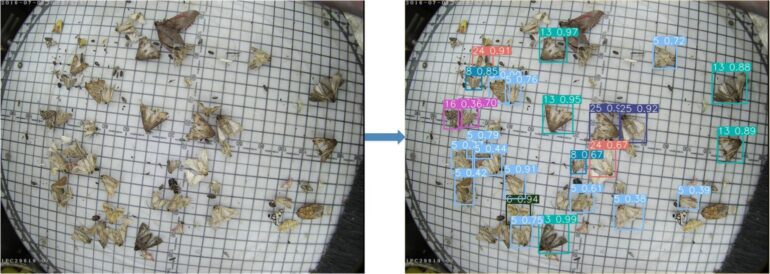TL;DR:
- Researchers from Murdoch University and the Western Australian Government have developed an AI-powered insect identification system.
- The system achieves an ID accuracy of 72.1% and a fast detection rate of 63.8 images per second.
- YOLOv3, a machine-learning platform, is used for efficient and simple insect detection.
- The system incorporates a feature to learn differing spatial elements for improved accuracy.
- Traditional manual counting methods are labor-intensive and time-consuming.
- AI-driven automatic detection of agricultural insects is now feasible.
- The algorithm was trained using a dataset of 25,878 insect images.
- The system outperforms existing object detectors in insect detection accuracy.
- Challenges include identifying overlapping insects and those with similar colors and shapes.
- Future research aims to address these limitations and improve detection accuracy.
Main AI News:
Cutting-edge research conducted by scientists from Murdoch University and the Western Australian Government has resulted in a remarkable feat—the development of an artificial intelligence (AI) system capable of identifying insect pests faster and more accurately than any other technology available. Boasting an impressive ID accuracy rate of 72.1 percent and a rapid detection rate of 63.8 images per second, this AI-powered insect detector has surpassed existing techniques in the realm of pest identification.
The breakthrough was achieved through the implementation of YOLOv3, a machine-learning platform known for its efficiency and simplicity in object detection across various sizes. The researchers enhanced the system by incorporating a feature that enables the detector to learn distinct spatial elements, resulting in enhanced accuracy and speed.
Traditionally, the labor-intensive and time-consuming process of visual inspection and manual counting was relied upon to gather information about insect populations. However, the introduction of AI and deep-learning techniques have revolutionized the field, making automatic detection of agricultural insects a viable solution. Professor Ferdous Sohel, the lead researcher and an expert in information technology, emphasized the importance of developing multi-insect detection strategies as an integral part of effective pest management.
To train the system, the researchers utilized a dataset consisting of 25,878 images of insects, including beetles, weevils, and moths. The algorithm achieved a mean average precision rate of 71.6 percent. By addressing the complexities associated with insect images featuring intricate backgrounds, the team further improved the detection accuracy by an additional 3 percent.
Insect detection poses a unique challenge for computer algorithms due to the small size of the objects in question. The limited resolution of insects in images, along with obstacles such as occlusion, noise, and lack of distinct features, makes detecting tiny objects within large datasets a demanding task.
Experimental results demonstrate a significant advancement in insect detection accuracy compared to existing state-of-the-art object detectors while maintaining minimal impact on processing speed. The developed AI algorithm showcases real-time automatic insect detection capabilities within a large-scale agricultural pest dataset.
While the system excelled in various aspects, there are areas for further improvement. The model’s performance was less effective when handling images with overlapping small insects, and difficulties arose in identifying insects with similar colors and shapes. Additionally, differences in size and scale within the dataset created challenges and impacted detection accuracy. Future research will focus on addressing these limitations, with a particular emphasis on detecting overlapped insects, insects with high similarity, and variations in scale.
This groundbreaking achievement in pest identification demonstrates the potential for AI to revolutionize the field of agriculture and pest management. The development of highly accurate and efficient insect detection systems promises to significantly enhance monitoring and control measures, leading to improved agricultural practices and increased yields.
Conlcusion:
The development of an AI-powered insect identification system holds significant implications for the market. By surpassing existing techniques in accuracy and speed, this breakthrough technology has the potential to revolutionize pest management and agriculture practices. The automation of insect detection through artificial intelligence streamlines processes, eliminating labor-intensive and time-consuming manual counting methods.
The enhanced accuracy and efficiency offered by this system provide businesses in the agricultural sector with valuable tools for monitoring and controlling pests, ultimately leading to improved crop yields and optimized resource allocation. As advancements continue to address limitations and improve detection capabilities, the market can expect to witness transformative changes in pest management strategies, further emphasizing the role of AI in driving innovation and sustainability in the agricultural industry.

